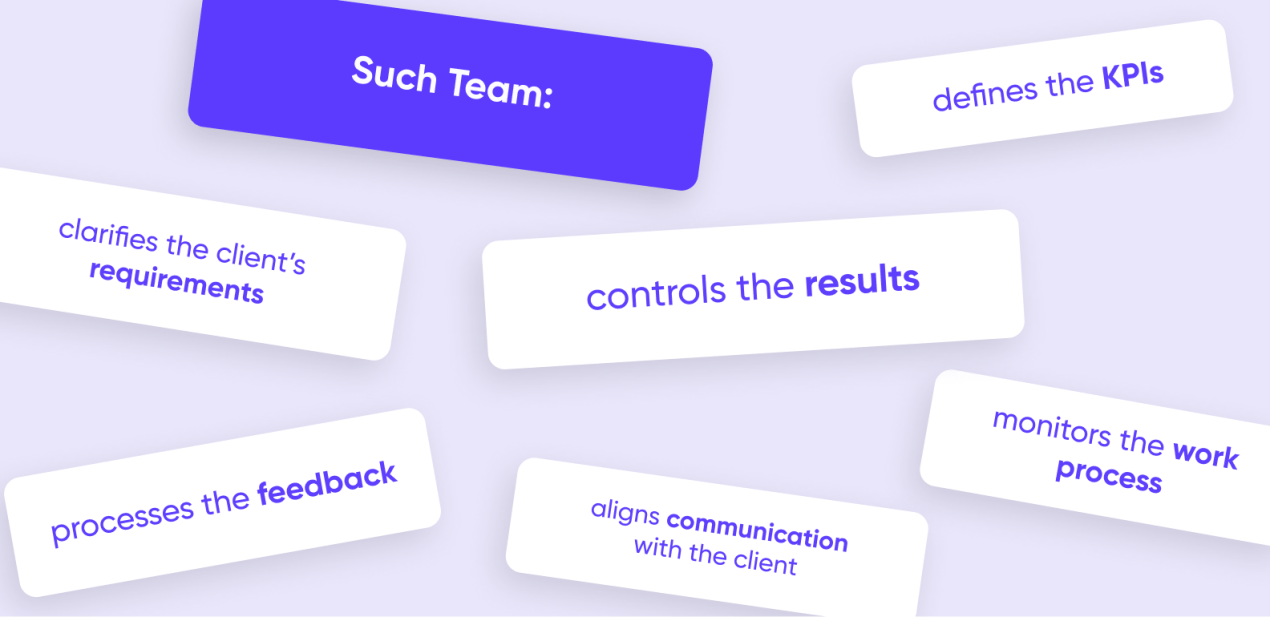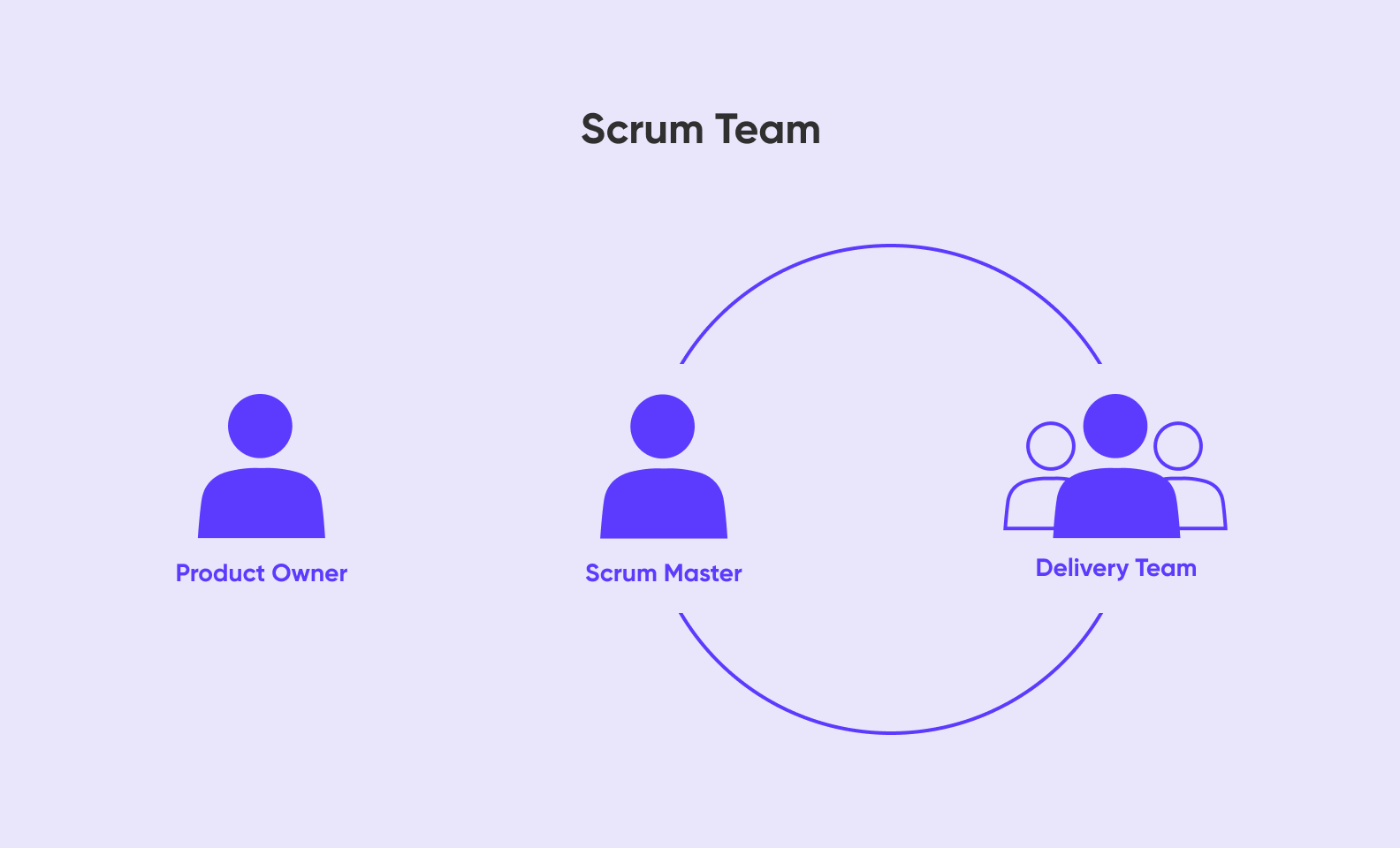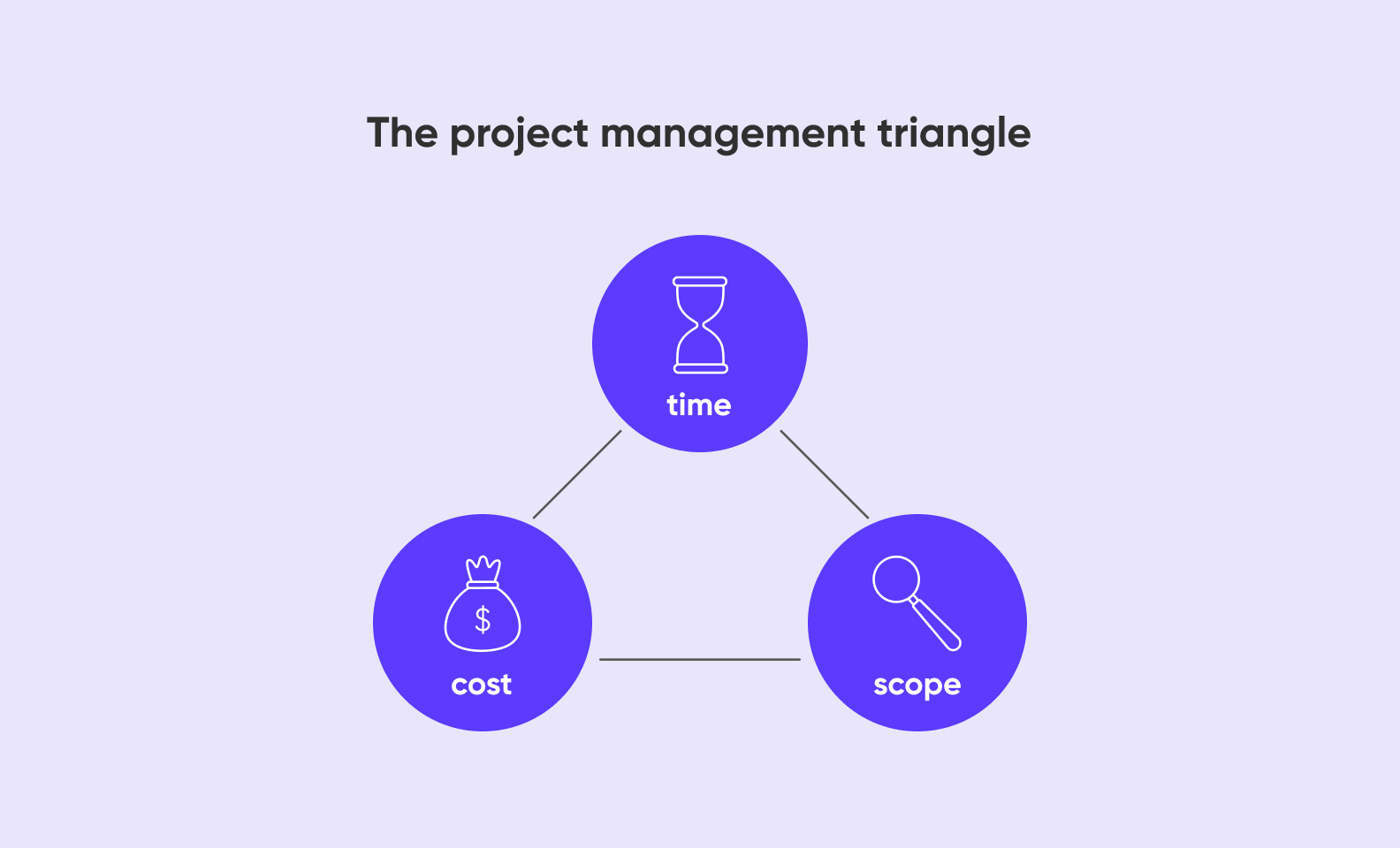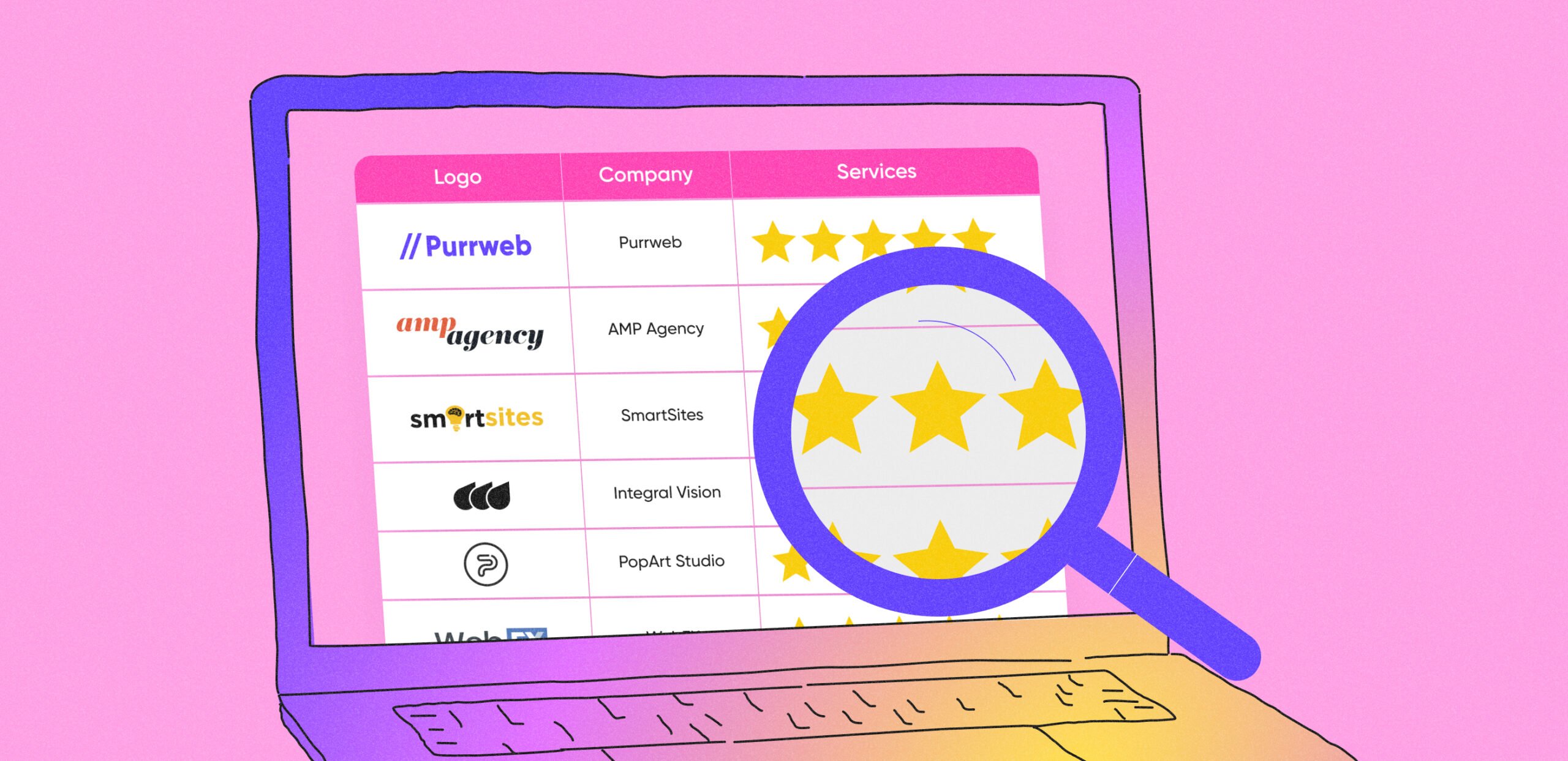What tasks does project management help you to tackle?
The project management consulting team helps you with organization, monitoring, and control of your project.
There may be turn-key project management solutions or one-shot consultations. In the first case, you get a step-by-step project plan, the organization of all the processes on every step of the development, and the ready product in the end. In the second case — answers to your questions, like how to build communication and the process in a remote team or how to accept the tasks that the team accomplished.
What is a project management team?
In most cases, web studios use the agile methodology Scrum in the development of IT products. In a classical Scrum Team, there is a Scrum Master, the Product Owner, and the Development Team. The Scrum Master and the Product Owner manage the development process while the Development Team develops the product.
Let’s talk in detail about the Scrum Master and the Product Owner.
Scrum Master is responsible for interactions between the members, tackling problems in teamwork. He is a fully-valid member who is involved in the technical implementation of the product but to a greater degree maintains the team vibe and makes sure that the team follows the Scrum methodology.
The Product Owner or PO understands the main idea of the product and project business goals. PO makes sure that the final product corresponds to the business goals. He sees the product on the macrolevel, directs the team, prioritizes the tasks, and controls the results.
Most often the Product Owner is the client’s representative. He understands what the result should look like but doesn’t know how to get to it. That’s why there should be a project manager.
Project Manager or PM coordinates the development process and communicates with the client. The thing is that the client and the developers live in absolutely different worlds.The developers want to boost their skills. They do not always correctly estimate the time needed to develop a feature. The client on the other side wants to release the app as fast as possible with the least expenses. The client needs the dates and assurances but the developers cannot guarantee that the app will successfully roll out on time.
Now, if a client will directly work with the developers, it will be tough for both sides: the developers promise to “someday” deliver “something”, the client doesn’t get when the whole thing will roll out. Thank God, there are PMs.
PM is an interpreter from “developerish” into “clientish”. He understands what the client wants and which tasks to give to developers to get the desired product. It’s crystal clear to him when the app will be released, how it should look like, and how to plan the developers’ workload. And the most important — he gives assurances and holds responsibility for it.
One person cannot combine all three roles together. But being a PO to employ a PM and a Scrum Master is a bit too much for a startup. Employment expenses, equipment, and training — all for the development of one app.
The Project Management Institute (PMI) states that more than 68% of startups and companies outsource project management. We also think that it’s way easier to outsource project management to professionals. In the long-term, you save money without losing in quality.
4 stages of project management
Even if you outsourced project management, it’s better to know a thing or two about the way it works. In such a way, you will be aware of which stage you’re currently at, what awaits you, and when you need to communicate more with the team.
1. Project Initialization
At this stage, the PM together with the client defines the milestones, the project goals and draws the project management triangle — trying to find the balance between the cost, time, and scope. Simultaneously the PM puts a team together, distributes the roles and responsibilities; defines the communication channel.
If the client wants to get the desired product in the budget, he needs to communicate a lot with the team on the project initialization stage. At the start, the team needs as much input about the product as possible: the functionality; the business goals; the order of priority. It all translates into deadlines and the budget.
It’s often the case that the client’s “wish list” was totally taken into account and the rough quote is 1000 development hours. Well, it’s great that we’ve checked that all out at the start but now we have to turn on the “cut off all the unnecessary” mode.
Usual PM grind…
Support chat? — Nope, the text form “What’s the problem” will work.
Apple and Google Pay integrations? — Yandex.Kassa is actually enough.
At the end of the initialization stage, the team composes the project documentation with the product requirements — this doc. plays a huge role in the planning stage.
2. Planning
On the initialization stage, we already get the rough estimate in hours. The detailed estimation of the project is done on the second stage though.
The PM and the team prepare tasks, estimate them, and assign the team members to them. As a result, we get a detailed project execution plan which is then approved by the client.
If the client is still sad about the estimation, a la 800 dev hours instead of 500, we can step back and cut some features off the MVP. Yep, launching the project is mostly about cutting off the unnecessary stuff.
When the client gives a green light — it’s time to code.
3. Execution and control
Technically execution and control are separate project stages, we consider it together though — execution without control is a recipe for a project failure.
The developer starts working on the task. 20 hours pass by, boom. “The feature is working” — says he.
The QA comes into play. Checks the first flow — the feature works indeed. Check the second flow — whoops, the feature doesn’t work.
Technically, the developer is right, the feature is working but only in one of the use cases. But the client wants the app to work stably in each case.
“If a feature works from the first time, then there is definitely a bug” — conventional wisdom
In the planning stage, the team creates the product. If the team works by Scrum methodology, they iteratively create parts of the product, fix bugs, approve it with the client, and go to the next chunk. The plan can be changed on the fly: the client may halve the budget or realize that actually, the product may hold up without Yandex.Kassa.
The most important for the client here is to not lose sight of product goals and make them clear for the PM. In the end, it’s his job to translate these requirements into “developerish”.
The final result — product release.
4. Project close-out
The last phase of the project life cycle is the delivery of the final product.
After the release, the Development Team improves the code, fixes bugs, and writes technical documentation for the product so that the product would not be dependent on one project team and could be modified by other developers.
When is it better to consult PM experts?
Need practical recommendations
Have an idea and the Development team but do not know how to organize the teamwork? PM experts will help you get the project going smoothly: give pointers on how to set up the team and how to integrate the new mechanisms into the working ones.
Things go wrong
The budget runs short but no result yet? Maybe your Development Team doesn’t know how to bring the project to release. An expert will bring clarity into the actual situation and will find the showstoppers and figure out how to fix it.
Want to breed in-house experts
Plan to create an in-house PM team but don’t know how to do that? Going to a consulting company is a working option.
Many outsourcing agencies train the PM newbies: share the methodology, give practical instruments and teach how to apply it all in real life.
➕ The pros of project management outsourcing
As you see, PM outsourcing is not only about resolving urgent problems on the fly but also about long-term advantages. Here are some of them.
Saving on fixed costs
You just hire a contractor and use external expert knowledge by contract. It means that you don’t need to employ people, invest in staff development and create internal infrastructure. Pay only for the result.
Flexible cooperation
Project management outsourcing is a flexible type of cooperation. Whether it’s packed up project management, implementation of particular methods and instruments, or one-shot consultation — you can get it all on the outsource. The client just has to compose his “wish list” and the agency will know if they can help or not. If during the one-shot consultation, you realize that you need turn-key project management, it’s not a problem — you can always extend the initial contract.
Working with the experts
PM experts already took their knocks. And why do you have to step on a rake yourself, if you can simply consult with those who already did that and know how to walk round it. The experts already know the bottlenecks and help you minimize the effect of it on the early stages of the project. The fewer bottlenecks and risks there are, the smoother the process goes and the less money the client pays in the end.
➖ The cons of project management outsourcing
It may seem as if there is nothing better than outsourcing. Well, it’s not true. Of course, there are some disadvantages and traps that need to be taken into account.
Information leak
Be ready to answer PM’s questions about the business processes of the project. And it’s in your best interests to explain it all in detail. In such a way, the product will fully meet your requirements, not the PM’s assumptions about how it should work.
However, if your company already holds a huge market share, the competitors are always wide awake and want to know ins and outs of your inner workings. There is a risk that the competitor will ask the outsourcing company about that. And the outsourcing company will not reject. For a price, of course.
Or let’s take the case when you have a ready-made design. The web studio starts developing the product according to it but then suddenly gives up on it. It is possible that they simply sold your design to another client.
To soften the blow, you may ask the contractor to sign an NDA. In such case, even if the agency makes a weird trick, you can receive compensation for it.
We advise you to save time on experiments and thoroughly study the references about contractors. Recently we’ve composed a checklist on choosing the right contractor. You can read it here:
Dependence
If you outsource product development, you become dependent on the contractor. If the business starts going bad for them or suddenly they cut down the staff, the product release becomes jeopardized — a sad situation. Here the references and general judgment about company stability will work.
If the references are OK and guys have been a while on the market and do not plan to stop, ask them about the project transition process. The right thing — the detailed project documentation.
The level of dependence is the highest at the project start, so only 3-4 months. By the release, the developers compose project documentation so that further support could be done by your team.
The risk of getting a pig in a poke
Here is a pretty common situation: an outsourcing company asks for full prepayment, develops something, fobs the client off with the promises, and promises to launch a rocket any minute now. In reality, the client gets a part of a bugged app and an invoice for 1 more month of development with the following words: “Well, you know, we have some problems”.
If you don’t want such a thing to happen, check that the agency works by Scrum methodology. It’s the best option for a client. Every 2 weeks he pays for working features. If an app is bugged or something goes wrong, you can always stop cooperation, just take what is already done and find another contractor. You risk only with the cost of 2-weeks sprint.
In conclusion
You know there are times when you hire a designer and he creates technically unrealizable products. Or Senior React Native developer turns out to be not senior and not React Native.
In Purrweb, we know that it’s better to consult an expert at the project start and minimize fundamental risks up front than put out a fire in 2 months.
Contact us, if you need help at any stage of the project.














